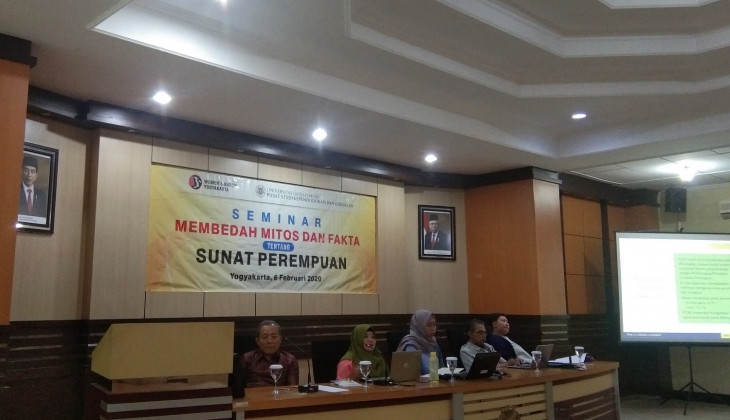February 6th is celebrated as the International Day of Zero Tolerance for Female Genital Mutilation. Unfortunately until now, this practice is still found in many countries in the world, such as the Middle East, also Africa and Asia, including Indonesia.
2016 UNICEF data recorded that more than 200 million women and children worldwide are victims of female circumcision. Meanwhile, Indonesia is ranked third in the country with the highest female circumcision rate in the world after Egypt and Ethiopia.
“According to the report, half of girls aged under 11 years or around 13.4 million in Indonesia are forced to experience practices that violate women’s rights to health, security, freedom of opinion, freedom from torture and other degrading treatment,” said the Women’s Network activist Yogyakarta, Ika Ayu, Thursday (6/2) in a discussion on Dissecting Myths and Facts About Female Circumcision at UGM PSKK.
Ika said that the practice of female circumcision must be renounced, because it violates the sexual and reproductive rights of individuals. In addition, this practice also becomes a form of sexual control, including through discriminatory regulations on the grounds of morality and religion, and forms of submission and discipline of sexuality.
“Not only that, the practice of female circumcision strengthens patriarchal norms that if women are not circumcised, it will threaten the norms of society. It should be renounced because there is also no medical argument that supports this practice,” she explained.
According to her, the current Indonesian government does not have a clear attitude towards female circumcision. The difference in defining between the WHO Female Genital Mutilation (FGM) and the practice of female circumcision in Indonesia is a grey area which causes the government’s indecisiveness. The inconsistency of the government’s attitude towards female circumcision has made this practice considered acceptable and necessary by the people of the country.
“The state needs to show concrete evidence of the protection and fulfilment of the sexual and reproductive rights of every citizen by not allowing the practice of female circumcision to become necessary and reasonable to do,” she said.
Reproductive Health activist, Mukhotib M.D., said there are various reasons for female circumcision, one of which is a form of control of women. This practice is believed by a number of groups in society, to control women’s sexual desire.
“(The belief is that) Women must be kind, in this sense, not naughty and not expressive,” he said.
Female circumcision, he said, is still being discovered because it has been a tradition for generations in society. If these practices are not implemented, community stigmatization will occur.
According to him, female circumcision needs to be discarded because apart from not showing any medical benefits, this practice also violates children’s rights. In addition, female circumcision causes self-distrust and feelings of victimization.
A researcher of PSKK UGM, Sri Purwantiningsih, S.Si., M.Kes., conveyed that the practice of cutting or genitalia injury (P2GP) of women continues to occur in Indonesia. In fact, this practice is difficult to eliminate because of the socialization of norms related to P2GP.
“There is a reproduction of culture in the household. Grandmothers who are circumcised tend to circumcise their children (mothers) and mothers who are circumcised by their grandmothers also tend to circumcise their children,” said the researcher from Center for Population and Policy Studies (PSKK), Sri Purwantiningsih, S.Si., M.Kes.
From the results of a study conducted by PSKK UGM in 2017, involving 4,250 households in 10 Indonesian provinces, 87.3 percent of respondents received information about female circumcision from their parents. Religious doctrine as well as traditions in society are the reasons for the practice of female circumcision. As many as 92.7 percent of respondents said religious obligations were the reason for female circumcision and 84.1 percent for traditional reasons.
“As many as 97.8 percent of respondents said that female circumcision needs to be done,” he said.
While a lecturer at the Faculty of Sharia and Law, UIN Sunan Kalijaga, Dr. Hamim Ilyas, said that in Islam, the practice of female circumcision was not introduced or known. The origin of circumcision began with Prophet Ibrahim AS who performed it at the age of 80. At that time, circumcision was only performed on men.
He explained that in the Al-Quran there is no verse that directly refers to circumcision, both for men and women. The verse that is usually used as the basis is Surah An-Nahl verse 123 which instructs the Prophet Muhammad SAW to follow Ibrahim As’s millah (life guidance).
Hamim conveyed that there are different views on female circumcision among the schools because some declared it sunnah (encouraged), not obligatory, and obligatory.
“In Indonesia, the practice of female circumcision is often found because the dominant Syafi’i school of thought, which views female circumcision as obligatory,” he explained.
Source: https://ugm.ac.id/id/berita/18994-praktik-sunat-perempuan-masih-banyak-ditemukan-di-indonesia



